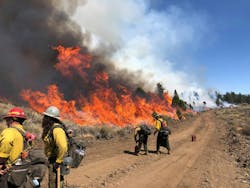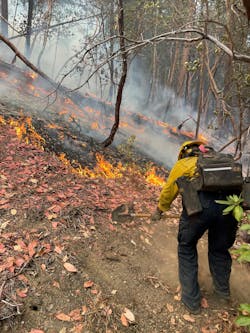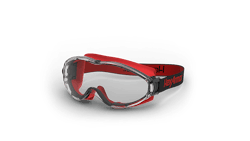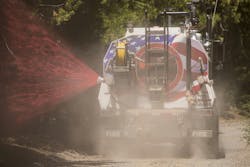Wildfire Suppression: Considerations for the Structural Firefighter
Firefighters are tasked with being an all-hazards emergency service practitioner. We are mandated with being a jack of all trades, master of all. From fire suppression and rescue to hazmat and EMS, the fire service is a clearinghouse for all emergency services that aren’t related to law enforcement. As populations expand and people relocate to more affordable housing, the likelihood of structural firefighters being tasked with wildland fire suppression increases exponentially.
Operational considerations
As seen in the structural firefighting environment, myriad operational considerations and associated tasks relate to wildland firefighting. Selecting the appropriate strategy, tactic and/or task for a specific incident requires a healthy balance of training and experience. It’s the senior firefighter’s or the officer’s mandate to impart this transcendent wisdom onto junior members. Building a quality mental slide deck is key to one’s ability to construct tactical intuition.
Pre-incident planning and preparation have been a fire service hallmark for decades. Prior to responding to a wildland incident, organizations must consider the potential threat to their community and anticipate resources that are required for mitigation. Based on this threat analysis, consideration must be given to developing and fostering aid agreements.
The nature of wildland firefighting demands the use of task-specific tools and equipment. Engine companies that respond to wildland fires often carry hose that’s designed for wildland operations and hand tools that are tailored to wildland-specific tasks. It’s no different than in the case of structural firefighting equipment: Targeted training always maximizes the equipment’s capabilities through the operator’s mastery.
The difference between structural firefighting fitness and wildland firefighting fitness is a dichotomy of strength versus endurance. Structural firefighting calls for time-condensed blasts of strength to pull hose, throw ladders and carry tools. In the wildland environment, it isn’t uncommon for firefighters to hike a significant distance, with elevation gain, to get to their area of operation. This might be done while carrying hand tools, hose packs or both. A robust physical fitness training program includes a healthy diet, avoidance of work-limiting substances, such as carbonated energy drinks, and a workout regimen that stresses strength as well as endurance.
Strategy and tactics
Incident command and the use of the incident command system are paramount to successful wildland operations. Developing an incident action plan (IAP) helps the incident commander and assigned resources to work harmoniously to accomplish the objectives. Initially, the IAP is verbal but transitions to a written document when the incident extends into multiple operational periods.
There are three strategic priorities on wildland fires: evacuation, perimeter control and structure defense. Each is accompanied by a corresponding list of tactical objectives, which are accomplished through the execution of defined tasks. All actions on a wildland fire should be guided by the lookouts, communication, escape routes and safety (LCES) principle and what’s described in “10 Standard Fire Orders” and “18 Watch Out Situations.”
Evacuation/perimeter control
On wildland fires, evacuation is necessary to remove the life-safety element from the ongoing risk assessment. Usually, what’s entailed in evacuation is best suited for law enforcement cooperators.
The area that’s the focus of the evacuation must be defined clearly in terms of its geography, with safe routes of travel identified and reasonable accommodation provided for safe egress out of the evacuation area.
Once evacuations are accomplished, consideration should be given to security in the evacuation area as a means to prevent theft and/or vandalism.
Perimeter control entails the actions that are required to stop fire spread. Tactically, resources attack the fire via two aproaches: direct and indirect. On a wildland fire, “going direct” places resources at the fire’s edge to extinguish through the application of water or through the removal of available fuel. Indirect attack involves preparing a containment line away from the fire’s edge. This might take the form of a hand line, dozer line or retardant line.
The selection of indirect attack is dictated largely by the presence of tactically advantageous geographical locations, such as ridgelines, roads and natural fuel breaks.
Mission-specific resources should be considered when conducting perimeter control. Brush engines, hand crews, heavy equipment and aviation resources likely will be needed on extended-attack incidents. Structural firefighters should become familiar with these resources, the tasks that they perform on a wildland fire and safe operation in their proximity.
Structure defense
There is no assignment on a wildland fire that structural firefighters are more comfortable with (and best suited for) than structure defense. Effective structure defense in the wildland fire is predicated on time and resources. Unfortunately, during initial attack, wildland incident firefighters rarely are afforded either option. Once an assignment is received, firefighters should triage the structures and infrastructure in their area of responsibility. A good mnemonic for structure triage is S-FACTS:
- Survival: Can you survive if fire affects your location? Is LCES in place?
- Fire environment: Can you survive the current and expected fire behavior? Consider fuel, weather and topographic influencers.
- Access: Is the access compatible with time and distance that are required to get to a safety zone?
- Construction/clearance: Does the structure have adequate defensible space? Will the building construction be defendable given the current and expected behavior of the fire?
- Time constraints: Is there time to mitigate safety concerns and to deploy resources for success?
- Stay or Go: Is it safe to stay? Is there time to prepare the structure prior to leaving? Is there benefit to staying and defending the structure?
The intent is to use available resources to protect the most without overcommitting. Once a crew receives an assignment, is made aware of the time restrictions and knows what resources are available, the crew can develop a structure defense plan.
The structural firefighter should consider preparing the structure (if possible) by removing combustible material away from the building, closing windows and doors, using aluminum foil to cover attic vents and turning off natural gas/propane.
Apparatus should be spotted close to the structure and oriented for rapid egress. Hydrants may be utilized as a water supply, but consideration should be given to the need for rapid egress.
Remember, the mission is the defense of property. If evacuations were completed successfully, there should be no need to risk one’s life for a building. Aside from the obvious risk to firefighter safety, trapped and overrun firefighters create an incident within an incident that requires otherwise-assigned resources to respond.
Post-incident
Like structural firefighting, it’s beneficial—and with some departments, mandatory—to conduct a wildland fire after-action review (AAR). This helps to answer five questions:
- What was the mission?
- What went well?
- What could have gone better?
- What might have been done differently?
- Who needs to know?
The process that’s required to conduct the AAR should allow equal contribution from all of the parties that were involved, and it should be carried out without placing blame. The results of the AAR might be memorialized in a document and used as a device to request tools/equipment and to recommend policy/procedure/guidelines or adjustments that must be made to existing aid agreements. The intent is to get better.
Master of all
More than ever, firefighting requires a diverse and ever-expanding skill set. Wildland fires will continue to increase in number and intensity, with firefighters, regardless of jurisdiction or specialty, called to the fire. To master your trade, you must be a master of all trades.
Product Spotlight
WILDLAND FIREFIGHTING TOOL
The patented Gorgui Classic multipurpose wildland firefighting tool from Vallfirest was designed based on the needs of the most advanced firefighting hand crews. Offering lightweight versatility on all types of terrain, the Gorgui Classic elegantly combines the functionality of all of the most commonly used tools for wildland fireline clearing in one.
SAFETY GOGGLE
When an emergency strikes, take charge with the durable, full-coverage FireArmor Wildland LT 300 safety goggle from HexArmor to safeguard your eyes against radiant heat, debris, fogging and other flying particles. The panoramic lens provides for a wide field of vision and 100 percent UV protection. The goggle fits over most prescription glasses.
GROUND-BASED FIRE RETARDANT
Ground-based PHOS-CHEK fire retardants from Perimeter Solutions are applied on flammable vegetation and cellulose fuels before a wildfire approaches to provide long-term protection that remains effective until a significant rain. PHOS-CHEK fire retardants have been used by the U.S. Department of Agriculture Forest Service for more than 60 years to help to prevent and suppress the spread of wildfires.
Wildland Fire Triangle
Three factors influence wildland fire behavior: fuel, weather and topography. They must be understood to facilitate tactical decision-making.
Fuel considerations include type of vegetation (grass, brush, trees), fuel moisture (dry or moist) and fuel continuity (contiguous or patchy). Fuel moisture is the most important of these considerations because of its direct effect on ignition potential and energy release. In dry seasons, fuels that have a high surface area-to-mass ratio likely will propagate fire and quick fire spread. Pretreatment of fuels should be avoided unless delivered via a retardant or gel.
Weather is the most dynamic fire behavior influencer. It affects wildland fire more than any other influencing factor. The three weather considerations are: wind (direction and speed), temperature (current and predicted) and relative humidity (current and predicted). Wind provides fresh oxygen and drives convection in the direction that it’s blowing. Relative humidity affects fuel moisture and, therefore, the capability for fuel to burn readily.
In simple terms, topography is the terrain where fuel is located. Topography influences fire behavior through slope (steepness), aspect (directional orientation) and height (measured in feet above sea level). Other topographic features, such as valleys, saddles and canyons, can influence fire spread and direction of growth.
Individually, each of these factors remains a consideration throughout an incident. When these factors come into alignment, significant fire growth should be anticipated. Alignment presents when a fire occurs during hot, dry periods in areas where topographic features contain contiguous fuel that will potentiate fire growth. These periods are going to be unique to each geographic region and shouldn’t be presumed to be a summer/fall problem.
About the Author

Andrew Roach
Andrew Roach is a battalion chief with the Victorville, CA, Fire Department. He has 20 years of experience in the fire service. Roach has been deployed to numerous wildland fires across California in a variety of capacities. He has a bachelor’s degree in fire administration from Columbia Southern University and a Certificate of Specialization in leadership and management from Harvard Business School. Roach also is a paramedic and California Executive Chief Fire Officer.





